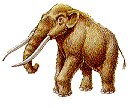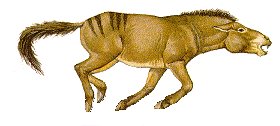Agate Fossil Beds
Official Map and Guide
The North American Scene--Pliocene
Began 5 million years ago
Most of the life-forms of the Pliocene Epoch would have been recognizable to us today. Many individual species were different, but distinguishing characteristics of various animal and plant groups were present. Evidence of wet meadows and dry open grassland environments have been found in the Pliocene. Toward the end of this period grasslands spread across much of North America, brought on by an ever cooler, ever drier climate. Horses and other hoofed mammals and the powerful, intelligent predators that preyed on them continued to prosper.
| Mastodons migrated to North America during the Pliocene. They were later joined in the early Pleistocene by another elephant group called mammoths. By the late Pleistocene, both mammoths and mastodons had become extinct, possibly due to climatic changes or hunting by paleoidians. Hagerman Fossil Beds NM |  |
 | Willow, alder, birch and elm grew on the ancient river palins of the Pliocene. These same plants are found in riparian habitats today. Hagerman Fossil Beds NM |
| Horses such as this early zebra-like version of the modern-day horse were superbly adapted to life on the grassy plains. Hagerman Fossil Beds NM |  |
Illustrations by Karen Barnes are based on fossil reconstructions found in R.J.G. Savage and M.R. Long's Mammal Evolution: An Illustrated Guide, New York: Facts on File Publications, 1986.
The drawings are not to scale.
Tree illustrations by John Dawson
Previous Section -- Offical Map and Guide-The North American Scene-Miocene
Return to Contents
Next Section -- Official Map and Guide-The North American Scene-Quaternary



